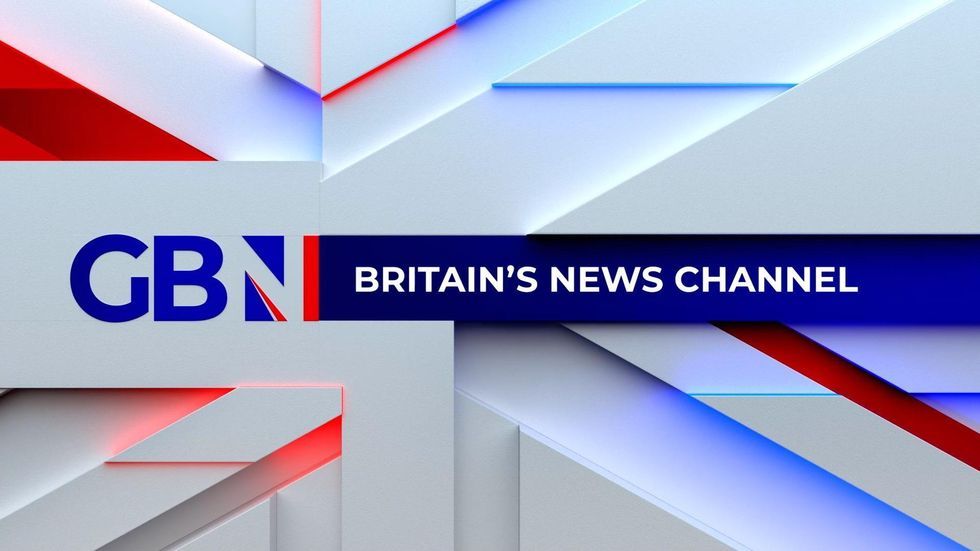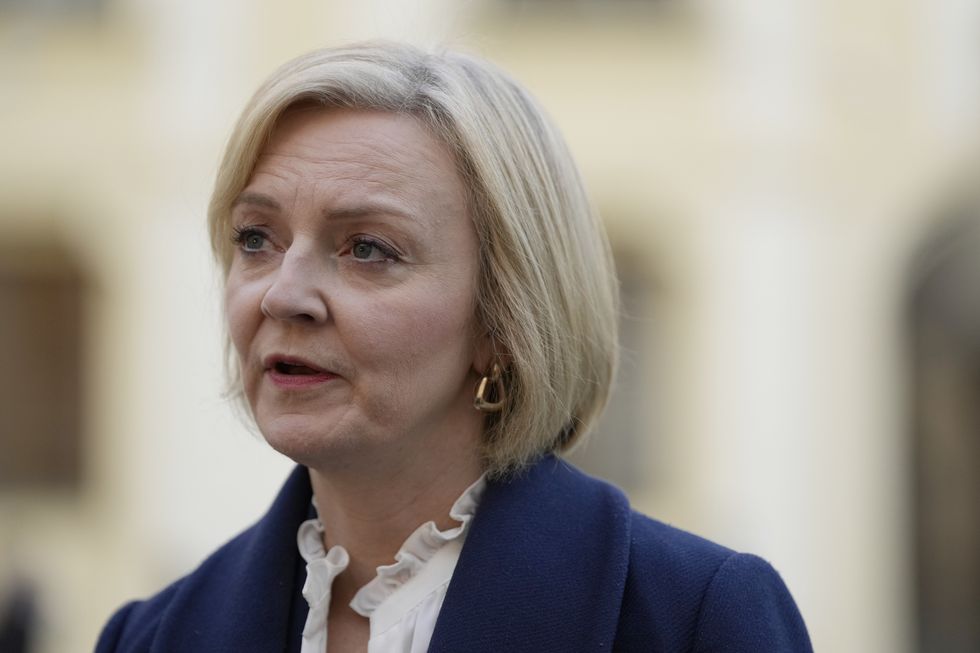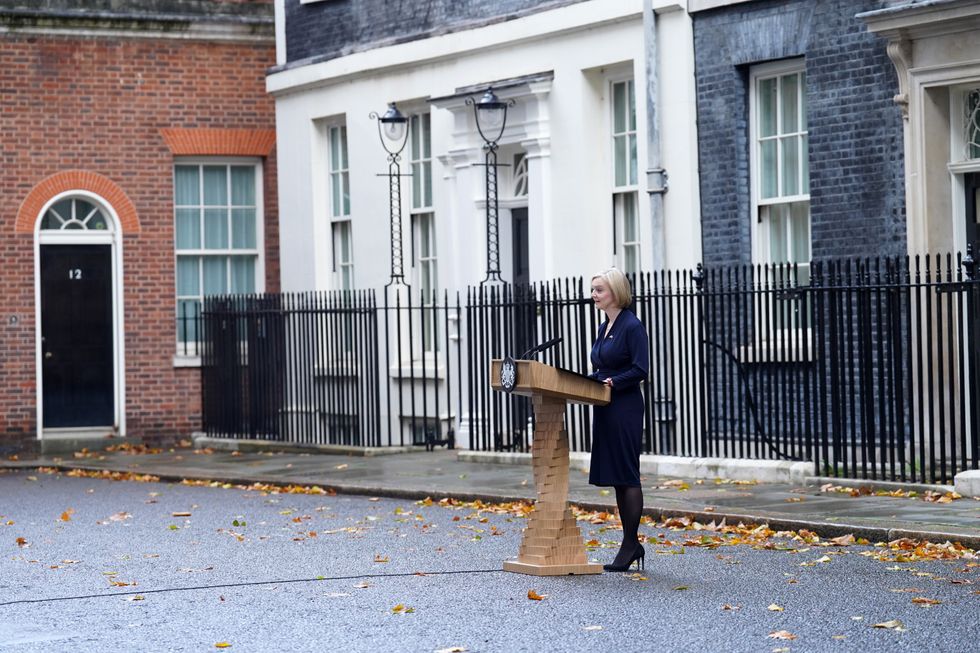Don't Miss
Most Read
Trending on GB News
After just six chaotic weeks in No 10, Liz Truss dramatically quit on Thursday, having lost two Cabinet members, the confidence of Tory MPs and control of the economy.
Not even 24 hours after declaring herself “a fighter, not a quitter”, Ms Truss announced her resignation outside No.10.
As a result, Ms Truss is set to become the shortest serving Prime Minister in history.
Here are the key moments of her premiership:
Liz Truss
Alistair Grant
– September 5: Liz Truss is the victor in the Tory leadership contest and will become the country’s next prime minister. She promises a “bold plan” to cut taxes and grow the economy and “deliver on the energy crisis”.
– September 6: Ms Truss becomes Prime Minister after being invited to form a new government by the Queen at Balmoral. Later that afternoon, in her first speech in Downing Street, she says she is honoured to take on the role “at a vital time for our country”. Kwasi Kwarteng is appointed Chancellor of the Exchequer.
– September 7: Ms Truss uses her first Prime Minister’s Questions to promise to work with MPs across the House to tackle “the challenges we face” at a “vital time for our country”. She confirms she will set out her package of support to deal with soaring energy bills the following day.
– September 8: In Parliament shortly before midday, the PM announces a new energy price guarantee and promises support for businesses struggling with bills for six months, with targeted help for vulnerable firms beyond that. She describes it as “the moment to be bold”, adding: “We are facing a global energy crisis and there are no cost-free options.”
Soon after her economic announcements in the Commons, Buckingham Palace issues a statement saying doctors were concerned for the Queen’s health, and that the head of state was under medical supervision.
A Palace statement is released at 6.30pm, saying: “The Queen died peacefully at Balmoral this afternoon.”
– September 9: The King holds his first in-person audience with Ms Truss at Buckingham Palace. Politics all but comes to a halt as the country observes a national period of mourning.
– September 19: The Queen’s funeral is held at Westminster Abbey in London.
– September 23: Mr Kwarteng announces the biggest raft of tax cuts for half a century. Using more than £70 billion of increased borrowing, he sets out a package which includes abolishing the top rate of income tax for the highest earners and axing the cap on bankers’ bonuses while adding restrictions to the welfare system.
The pound falls to a fresh 37-year low as “spooked” traders swallow the cost of the spree.
Questioned by reporters later that evening, the Chancellor insists his plan will encourage investment in the UK and rejects the suggestion his economic announcement was “a gamble”.
– September 29: Almost a week on, the PM insists the Government had to “take urgent action to get the economy growing” in her first public comments since the mini-budget market turmoil.
– October 2: Ms Truss acknowledges mistakes over the mini-budget but says she is standing by her tax-cutting plan as she refuses to rule out public spending cuts.
The PM admits she could have done more to prepare the ground for Mr Kwarteng’s financial statement, and she faces accusations of throwing her Chancellor “under the bus” by saying the abolition of the 45p top rate of tax was made by him, and not discussed with the Cabinet.
– October 3: In a dramatic U-turn, Ms Truss and Mr Kwarteng abandon their plan to abolish the 45p rate of income tax for top earners.
“We get it, and we have listened,” the Chancellor says, in language echoed in a tweet from the PM less than 24 hours after she said she remained absolutely committed to the cut.
Somewhat embarrassingly, Ms Truss was still defending the 45p tax rate in a TV interview filmed just hours before the U-turn.
– October 4: Mr Kwarteng says the Queen’s death added to the “high-pressure” environment around the preparation of the mini-budget. In an interview with GB News, he says it is important to place the so-called fiscal event in the “context” of the Queen’s death and funeral.
– October 5: Ms Truss pledges she will “get us through the tempest” and “get Britain moving” as she delivers her first Tory conference speech as party leader.
– October 8: Four Cabinet ministers urge colleagues to rally behind Ms Truss as the PM battles to steady the Tory ship following a week blighted by infighting.
– October 10: Mr Kwarteng bows to pressure to bring forward the publication of his financial strategy and independent economic forecasts. Completing another U-turn, he agrees to set out his medium-term fiscal plan alongside Office for Budget Responsibility (OBR) predictions on October 31.
– October 11: As Parliament returns, the Chancellor is warned, during a session of Treasury questions, that the Government’s economic credibility would be further shredded if he tries to push through the policies without the support of Conservative MPs.
– October 12: Ms Truss insists she will not cut spending to balance the books, despite economists and the financial markets continuing to question her plans.
She says she is “absolutely” not planning public spending reductions, but insists taxpayers’ money will be used well.
Liz Truss announced her resignation as PM on Thursday
Stefan Rousseau
– October 13: Mr Kwarteng says his “total focus is on delivering on the mini-budget” in response to speculation about a U-turn on the measures.
– October 14: Mr Kwarteng is sacked, having flown back early from International Monetary Fund talks in Washington. He says he has accepted Ms Truss’ request he “stand aside” as Chancellor.
The Prime Minister replaces her ideological soulmate at the Treasury with Jeremy Hunt, the former foreign secretary who backed her rival Rishi Sunak in the Tory leadership contest.
Ms Truss dismisses calls for her resignation at a hastily arranged eight-minute press conference in Downing Street, during which she takes just four questions from journalists.
She announces she is abandoning Mr Kwarteng’s commitment to drop the planned rise in corporation tax from 19% to 25% – even though it was a central plank of her leadership campaign – saving the Exchequer £18 billion a year.
Andrew Bailey, the Governor of the Bank of England, speaks to Mr Hunt following his appointment.
– October 15: The new Chancellor indicates the PM’s immediate economic plan is now largely defunct in a series of broadcast interviews.
Mr Hunt criticises the “mistakes” of the Truss administration and warns of “difficult decisions” to come on tax and spending.
In an unusual intervention, US President Joe Biden appears to join in the criticism of Ms Truss’s original plan, telling reporters “I wasn’t the only one that thought it was a mistake” and calling the outcome “predictable”.
– October 16: Former minister Crispin Blunt becomes the first Tory MP to publicly call for Ms Truss to quit, saying the “game is up” for the Prime Minister.
He is followed by Andrew Bridgen and Jamie Wallis, while other senior figures within the parliamentary party express deep unease with the PM’s leadership but stop short of calling for her to go.
Labour urges Ms Truss to come before Parliament to face MPs.
– October 17: Mr Hunt ditches the bulk of the PM’s economic strategy in an emergency statement designed to calm the markets.
The Chancellor scales back the energy support package and scraps “almost all” the tax cuts announced by his predecessor.
He abandons plans to slash the basic rate of income tax by 1p – which had been due to be brought forward to April – saying it will remain at 20p in the pound until the country can afford to reduce it.
The cut in dividend tax promised by Mr Kwarteng is also axed in the policy bonfire, along with VAT-free shopping for overseas tourists, the freeze on alcohol duty, and the easing of the IR35 rules for the self-employed.
Ms Truss sits silently in the Commons for roughly 30 minutes as her Chancellor informs MPs of the change of direction, staring straight ahead as he bins huge chunks of her plan.
The PM admits to a meeting of the One Nation group of Tory MPs that “we tried to do too much too quickly”, as she seeks to shore up support for her premiership.
– October 18: Ms Truss survives a meeting of the Cabinet without any ministers calling for her to quit, while Mr Hunt tells colleagues they must review departmental budgets to find ways to save taxpayers’ money.
Downing Street sparks a backlash by indicating ministers could ditch their commitment to the pensions triple lock.
The Prime Minister addresses Tory MPs from the European Research Group (ERG), telling them that she found axing her tax-slashing programme “painful” and did it “because she had to”.
Mr Hunt meets Sir Graham Brady, chairman of the powerful 1922 Committee of backbench Conservatives.
– October 19: The PM declares she is a “fighter, not a quitter” and insists she is “completely committed” to the triple lock on state pensions at PMQs.
Tory MPs are told a Labour vote in the Commons seeking to ban fracking is being treated as a “confidence motion” in Ms Truss’s embattled Government.
Deputy chief whip Craig Whittaker warns his colleagues the vote is a “100% hard” three-line whip, indicating that dozens of Conservatives who oppose the controversial gas extraction method face being kicked out of the parliamentary party if they do not follow orders in the lobbies.
But confusion ensues when climate minister Graham Stuart tells the Commons: “Quite clearly this is not a confidence vote.”
It leads to ugly scenes at Westminster, with Cabinet ministers Therese Coffey and Jacob Rees-Mogg among a group of senior Tories accused of pressuring colleagues to go into the “no” lobby.
Labour former minister Chris Bryant claims some MPs were “physically manhandled”.
Meanwhile, Suella Braverman dramatically quits as home secretary, citing a “technical infringement” of the ministerial rules, and criticising Ms Truss’s “tumultuous” premiership.
Labour’s motion is defeated by 230 votes to 326, majority 96, but there is speculation that Chief Whip Wendy Morton and her deputy, Craig Whittaker, have resigned in fury at the handling of the affair.
At 9.49pm – more than two hours after the vote – No 10 issues a statement saying both remain in post.
Overnight, Downing Street says Mr Stuart was “mistakenly” told to say it was not a confidence motion, adding that Conservative MPs were “fully aware” it was subject to a three-line whip.
A spokesman says the whips will be speak to the Tories who failed to support the Government, and those without a “reasonable excuse” will face “proportionate disciplinary action”.
– October 20: Cabinet minister Anne-Marie Trevelyan says she believes “at the moment” it is “still the case” Ms Truss will fight the next election as Prime Minister.
But pressure on the PM continues to mount, with more backbenchers adding their names to the growing list of Tory MPs publicly demanding her resignation.
Speaker Sir Lindsay Hoyle says he has asked the Serjeant at Arms and other officials to investigate allegations made about incidents in the Commons on Wednesday night.
At around noon, as the Prime Minister’s official spokesperson tells reporters there are no changes to Ms Truss’s plan to stay in office beyond October 31, it is reported that she is in talks with Sir Graham Brady, chairman of the powerful 1922 Committee of Tory backbenchers.
A Downing Street source says Ms Truss invited Sir Graham to Downing Street as part of a “taking the temperature” exercise, gauging the mood of Tory MPs.
Just over an hour later, it emerges that Ms Truss will give a statement at Downing Street, and a lectern is swiftly set up outside the famous black door.
At 1.30pm, the Prime Minister steps out to the lectern and says she has told the King she is resigning as leader of the Conservative Party.
In a brief speech, she tells the country she recognises she “cannot deliver the mandate” which Tory members gave her a little over six weeks ago.
She says she will stay on as Prime Minister until a successor is chosen via a leadership election to be completed in the next week.












